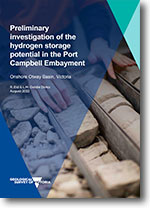Preliminary investigation of the hydrogen storage potential in the Port Campbell Embayment, Onshore Otway Basin, Victoria.
 |
| |||||
Product description:Summary: A preliminary investigation of the hydrogen storage potential of operating, depleted and unproduced gas fields in the Port Campbell Embayment has been undertaken by the Geological Survey of Victoria. This study seeks to understand the potential for hydrogen storage in the state and is based on the integration of results from the Victorian Gas Program (VGP). As the energy mix in Victoria transitions to low and no emissions sources, hydrogen production at scale is one alternative being considered to replace gas use. It is anticipated that underground storage of hydrogen in deep geological formations will be required to enable production facilities to operate at a capacity that will contribute to secure and reliable energy supply. Energy generation from renewable sources does not always match the demand for energy, especially during periods of peak demand. Hydrogen storage could support intermittent supply, where excess energy is converted to hydrogen and stored in geological formations in the subsurface. Research by Ennis-King et al. (2021) identified the areas of Australia that are likely to have favourable geology for underground hydrogen storage (UHS). In Western Australia, scoping studies to understand the potential for storage in depleted oil and gas fields have been completed (RISC, 2021). In Victoria, CO2CRC has indicated that field scale testing will form part of their forward research activities in the Port Campbell Embayment (CO2CRC, 2022). The Port Campbell Embayment was chosen for the study as it hosts twenty gas (methane) fields which are depleted, unproduced or have been repurposed. Seasonal storage and withdrawal of natural gas currently occurs approximately one kilometre underground in three depleted gas fields and forms an important component of Victoria’s gas supply infrastructure. Commercial underground gas (methane) storage (UGS) and carbon, capture and storage (CCS) demonstration projects have been safely operated in the area for decades. A qualitative assessment of storage potential by Ennis-King et al. (2021) highlighted the onshore Otway Basin fields as being suitable for UHS with future work required to find the best options in terms of storage characteristics, economics and location in relation to production and infrastructure. Subsurface hydrogen storage has similar geological requirements to UGS, including a suitable reservoir into which hydrogen can be injected and subsequently withdrawn, a seal rock overlying the reservoir to contain the hydrogen, and a workable storage volume. This study of the storage potential of the Port Campbell Embayment focused on the geological characterisation of the Waarre Formation-Belfast Mudstone reservoir-seal pair based on new data from the VGP. Reservoir injectivity was updated from Bagheri (2019). Seal capacity was calculated from available threshold pressure data, and VGP seal integrity studies were reviewed. This study shows that there is potential for UHS in the Port Campbell Embayment. Seal capacity analysis indicates that the Belfast Mudstone is capable of retaining column heights of hydrogen ranging from 55 to 1267 metres which mostly exceeds the greatest known vertical closure of 88 metres in the onshore Otway Basin. The hydrogen storage capacity of each field has been calculated and, with the injectivity results, used to rank its suitability for UHS. The total working gas capacity for hydrogen storage in the Port Campbell Embayment is assessed to be approximately 120 Bcf (equivalent to 43 PJ or 300 kt). The most prospective site for hydrogen storage in the Port Campbell Embayment is theIona field which has an estimated working gas storage capacity of 25 Bcf (equivalent to 9 PJ or 64 kt of hydrogen). Other higher-ranked sites are Boggy Creek, Naylor and McIntee. Mid-ranked sites include North Paaratte, Langley, Mylor and Tregony, each having storage capacities greater than 5 Bcf, while the remaining twelve sites, where storage capacity is less than 5 Bcf, are low-ranked. Wild Dog Road, Wallaby Creek, Croft and Buttress are the most prospective of the lower ranked sites. The depleted, unproduced and repurposed gas fields assessed in this preliminary study have UHS potential; however, more detailed evaluation of individual sites is required before progressing to a demonstration or pilot project. Additional work is required to identify other potential UHS sites in other parts of the Otway Basin that could support future hydrogen production in southwest Victoria. Multiple options for storage in the Otway Basin will serve to increase the likelihood of success of the hydrogen industry in the state. Bibliographic reference: Eid, R. & Goldie Divko, L.M., 2022. Preliminary investigation of the hydrogen storage potential in the Port Campbell Embayment, Onshore Otway Basin, Victoria. Geological Survey of Victoria Special Publication. Geological Survey of Victoria, Department of Jobs, Precincts and Regions, Melbourne, Victoria, 56 pp. Download: The downloadable version of this report is supplied in (pdf format 15.5 MB), Attachment A1 (xlxs/ods 7 kb) and Attachment A2 (xlxs/ods 20 kb). | ||||||

